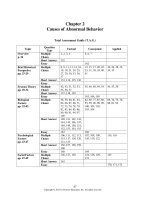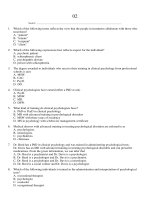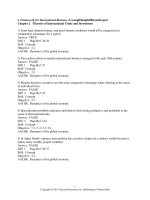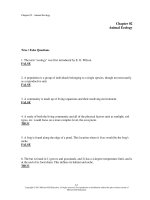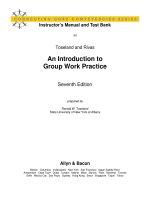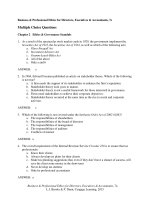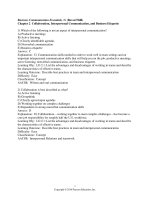International business 7th edition griffin test bank
Bạn đang xem bản rút gọn của tài liệu. Xem và tải ngay bản đầy đủ của tài liệu tại đây (219.57 KB, 29 trang )
International Business, 7e (Griffin/Pustay)
Chapter 2 Global Marketplaces and Business Centers
1) Which of the following is LEAST responsible for driving the floriculture industry?
A) technological changes
B) competitve rivalries
C) trade liberalization
D) state capitalism
Answer: D
Diff: 2
Skill: Concept
Objective: 1
2) FloraHolland is best described as a(n) ________.
A) cooperative floral auction organization
B) international floral import corporation
C) small, independent flower grower
D) floral industry stock program
Answer: A
Diff: 2
Skill: Concept
Objective: 1
3) Which of the following best explains the success of FloraHolland?
A) use of e-commerce
B) availability of cheap labor
C) creation of a futures market
D) acquisition of inexpensive land
Answer: C
Diff: 2
Skill: Concept
Objective: 1
4) The patterns of trade and investment in international business are LEAST affected by ________.
A) linguistics
B) cultural ties
C) education trends
D) military alliances
Answer: C
Diff: 2
AACSB: Dynamics of the global economy
Skill: Concept
Objective: 1
Learning Outcome: Explain how differences in culture affect the international business environment
1
Copyright © 2013 Pearson Education, Inc. Publishing as Prentice Hall
5) Companies doing international business are more likely to be successful when they ________.
A) conduct frequent performance appraisals
B) understand local market characteristics
C) employ primarily local managers
D) rely on experienced expatriates
Answer: B
Diff: 2
Skill: Concept
Objective: 1
6) What is London's origin as a world financial center?
A) military power of British Empire in the nineteenth century
B) influence of royalty on the city's reputation
C) rule over several former American colonies
D) prestige of the London Stock Exchange
Answer: A
Diff: 2
Skill: Concept
Objective: 1
7) Which of the following markets has the LEAST impact on the world's current economic activity?
A) North America
B) European Union
C) China
D) Japan
Answer: C
Diff: 3
AACSB: Dynamics of the global economy
Skill: Concept
Objective: 1
Learning Outcome: Discuss trends in and the debate over globalization
8) In the twenty-first century, growth rates in ________ have outpaced those in ________.
A) the United States and China; India and Japan
B) Canada and Japan; Germany and the U.S.
C) Japan and India; China and Canada
D) China and India; Germany and Japan
Answer: D
Diff: 3
Skill: Concept
Objective: 1
Learning Outcome: Discuss trends in and the debate over globalization
2
Copyright © 2013 Pearson Education, Inc. Publishing as Prentice Hall
9) The European Union accounted for about ________ percent of the world's GDP in 2009.
A) 15
B) 28
C) 45
D) 52
Answer: B
Diff: 2
Skill: Concept
Objective: 2
10) Which country has the highest per capita income in North America?
A) the United States
B) Central America
C) Canada
D) Mexico
Answer: A
Diff: 1
Skill: Concept
Objective: 2
11) The countries of North America produce approximately ________ percent of the world's output.
A) 18
B) 29
C) 45
D) 52
Answer: B
Diff: 2
Skill: Concept
Objective: 2
12) ________ is the currency in which the sale of goods and services is denominated.
A) Flight capital
B) Euro currency
C) Invoicing currency
D) Capital substitution
Answer: C
Diff: 1
Skill: Concept
Objective: 2
Learning Outcome: Define the fundamental concepts of international business
3
Copyright © 2013 Pearson Education, Inc. Publishing as Prentice Hall
13) The prime market for lower-income countries that are trying to raise their living standards through
exports is ________.
A) the United States
B) Japan
C) Germany
D) China
Answer: A
Diff: 2
Skill: Concept
Objective: 2
14) ________ is the money sent out of a politically or economically unstable country to one perceived as
a safe haven.
A) Invoicing currency
B) Flight capital
C) Capital substitution
D) Foreign currency
Answer: B
Diff: 1
Skill: Concept
Objective: 2
Learning Outcome: Define the fundamental concepts of international business
15) When a firm makes a sale of goods denominated in Japanese yen, the yen is referred to as ________.
A) flight capital
B) export capital
C) the invoicing currency
D) the transaction currency
Answer: C
Diff: 2
Skill: Concept
Objective: 2
Learning Outcome: Define the fundamental concepts of international business
16) Which country listed below commonly attracts flight capital?
A) Germany
B) Canada
C) the United States
D) Singapore
Answer: C
Diff: 1
Skill: Concept
Objective: 2
4
Copyright © 2013 Pearson Education, Inc. Publishing as Prentice Hall
17) U.S. exports of goods and services in 2010 accounted for about ________ percent of U.S. GDP.
A) 12
B) 23
C) 30
D) 45
Answer: A
Diff: 3
Skill: Concept
Objective: 2
18) About what percentage of the world's 500 largest corporations in 2010 were headquartered in the
United States?
A) 12%
B) 19%
C) 27%
D) 45%
Answer: C
Diff: 2
Skill: Concept
Objective: 3
19) Which of the following is not true of Mexico?
A) It is the world's largest Spanish-speaking nation.
B) It has increased its protectionist measures in recent years.
C) It has been promoting the privatization of multiple industries.
D) It has signed free trade pacts with El Salvador, Guatemala, and Honduras.
Answer: B
Diff: 3
AACSB: Dynamics of the global economy
Skill: Concept
Objective: 3
Learning Outcome: Describe how differences in political economy influence economic development
20) ________ is the dominant market for Canadian goods.
A) The European Union
B) The United States
C) China
D) Mexico
Answer: B
Diff: 1
Skill: Concept
Objective: 3
5
Copyright © 2013 Pearson Education, Inc. Publishing as Prentice Hall
21) Which of the following aspects about Canada is a concern to many international investors?
A) legal system instability
B) separatist movement
C) weak infrastructure
D) education system
Answer: B
Diff: 3
Skill: Concept
Objective: 3
Learning Outcome: Describe how differences in political economy influence economic development
22) How many countries currently participate in the European Union's common currency, the euro?
A) 12
B) 17
C) 22
D) 27
Answer: B
Diff: 1
Skill: Concept
Objective: 4
23) Countries designated "middle income" have per capita incomes of ________.
A) less than $995
B) between $996 and $12,196
C) between $12,196 and $23,221
D) between $23,222 and $34,021
Answer: B
Diff: 2
Skill: Concept
Objective: 2
24) The European Union is comprised of ________ countries.
A) 12
B) 15
C) 22
D) 27
Answer: D
Diff: 1
Skill: Concept
Objective: 4
25) Which country is a low-income nation?
A) Cambodia
B) Costa Rica
C) India
D) Chile
Answer: A
Diff: 2
Skill: Concept
Objective: 2
6
Copyright © 2013 Pearson Education, Inc. Publishing as Prentice Hall
26) What is the most likely reason that Germany is considered the most important member of the EU?
A) Germany has the world's fourth largest economy.
B) Germany's government promotes human rights.
C) Germany initially suggested developing the EU.
D) Germany uses a codetermination system.
Answer: A
Diff: 3
Skill: Concept
Objective: 4
27) Which EU country has drawn criticism for promoting an agenda of economic nationalism, and in
particular, for protecting its farmers under the guise of the Common Agricultural Policy?
A) Germany
B) France
C) Italy
D) Spain
Answer: B
Diff: 2
Skill: Concept
Objective: 4
Learning Outcome: Describe how differences in political economy influence economic development
28) Who was responsible for introducing glasnost and perestroika to the Soviet Union?
A) Czar Nicholas II
B) Boris Yeltsin
C) Vladimir Putin
D) Mikhail Gorbachev
Answer: D
Diff: 2
Skill: Concept
Objective: 4
Learning Outcome: Describe how differences in political economy influence economic development
29) China is attracting the attention of multinational companies and investors for all of the following
reasons EXCEPT its ________.
A) move to adopt market-oriented economic policies
B) abandonment of many communist principles
C) hard-working, low-cost labor force
D) state ownership of key industries
Answer: D
Diff: 3
Skill: Concept
Objective: 5
Learning Outcome: Describe how differences in political economy influence economic development
7
Copyright © 2013 Pearson Education, Inc. Publishing as Prentice Hall
30) Which of these countries is NOT a member of the EU?
A) Austria
B) Monaco
C) Norway
D) Portugal
Answer: C
Diff: 1
Skill: Concept
Objective: 4
31) What country holds the world's largest land mass?
A) the United States
B) Russia
C) China
D) Canada
Answer: B
Diff: 2
Skill: Concept
Objective: 4
32) Who was Russia's first democratically elected president?
A) Mikhail Baryshnikov
B) Mikhail Gorbachev
C) Boris Yeltsin
D) Vladimir Putin
Answer: C
Diff: 1
Skill: Concept
Objective: 4
33) The Newly Independent States refers to the ________.
A) Central European countries
B) former Soviet republics
C) largest African nations
D) Four Tigers
Answer: B
Diff: 1
Skill: Concept
Objective: 4
34) Which of the following has achieved high-income status according to the World Bank?
A) the Czech Republic
B) Russia
C) Slovenia
D) Romania
Answer: A
Diff: 2
Skill: Concept
Objective: 4
8
Copyright © 2013 Pearson Education, Inc. Publishing as Prentice Hall
35) Russia's natural resources include all of the following except ________.
A) diamonds
B) natural gas
C) gold
D) grain
Answer: D
Diff: 2
Skill: Concept
Objective: 4
36) Immediately following World War II, Japan's Ministry for International Trade and Investment
encouraged firms to concentrate on ________.
A) steel and shipbuilding
B) automobiles and electronics
C) financial services
D) apparel and footwear
Answer: A
Diff: 2
Skill: Concept
Objective: 5
37) The Japanese term sogo sosha refers to a(n) ________.
A) major Japanese bank
B) family of interrelated companies
C) export trading company
D) supplier
Answer: C
Diff: 2
Skill: Concept
Objective: 5
38) The Japanese term, keiretsu, refers to a(n) ________.
A) major Japanese bank
B) family of interrelated companies
C) export trading company
D) supplier
Answer: B
Diff: 2
Skill: Concept
Objective: 5
39) Exports accounted for about ________ percent of New Zealand's 2009 GDP.
A) 10
B) 20
C) 30
D) 40
Answer: B
Diff: 1
Skill: Concept
Objective: 5
9
Copyright © 2013 Pearson Education, Inc. Publishing as Prentice Hall
40) Samsung, Hyundai, Daewoo Group, and LG are all examples of ________.
A) chaebol
B) keiretsu
C) glasnost
D) sogo sosha
Answer: A
Diff: 2
Skill: Concept
Objective: 5
41) Which of the following is most likely a true statement about New Zealand?
A) The country prohibits privatization in most industries.
B) Most of the country's population lives on the South Island.
C) The country primarily relies on its gold and coal resources.
D) Merchandise trade is extremely important to the country's GDP.
Answer: D
Diff: 3
AACSB: Dynamics of the global economy
Skill: Concept
Objective: 5
Learning Outcome: Describe how differences in political economy influence economic development
42) All of the following except ________ are typical exports from New Zealand.
A) dairy products
B) meat
C) wool
D) petroleum
Answer: D
Diff: 2
Skill: Concept
Objective: 5
43) The Four Tigers are also called ________.
A) newly industrialized countries
B) newly independent states
C) commonwealth of independent states
D) commonwealth of industrialized countries
Answer: A
Diff: 2
Skill: Concept
Objective: 5
10
Copyright © 2013 Pearson Education, Inc. Publishing as Prentice Hall
44) The Four Tigers refers to the countries listed below except ________.
A) South Korea
B) Indonesia
C) Taiwan
D) Singapore
Answer: B
Diff: 1
Skill: Concept
Objective: 5
45) The World Bank classifies the Four Tigers as ________.
A) developing
B) middle-income
C) newly developed
D) high-income
Answer: D
Diff: 2
Skill: Concept
Objective: 5
46) What caused South Korea's economic growth to suddenly slow in 1997-1998?
A) collapse of the chaebol
B) return to Communist rule
C) Asian currency crisis
D) import substitution policies
Answer: C
Diff: 2
Skill: Concept
Objective: 5
47) The Korean term, chaebol, refers to ________.
A) a family-based conglomerate
B) workplace harmony
C) economic restructuring
D) cooperative banks
Answer: A
Diff: 1
Skill: Concept
Objective: 5
48) Which of the following African countries is not a major oil exporter?
A) Algeria
B) Gabon
C) Zambia
D) Libya
Answer: C
Diff: 1
Skill: Concept
Objective: 6
11
Copyright © 2013 Pearson Education, Inc. Publishing as Prentice Hall
49) The Republic of China is most commonly known as ________.
A) Taiwan
B) Vietnam
C) Hong Kong
D) Singapore
Answer: A
Diff: 1
Skill: Concept
Objective: 5
50) What is the most likely reason that Taiwanese businesses are increasingly investing in Chinese
factories?
A) demand for automated manufacturing
B) need for low-wage workers
C) government requirements
D) need for additional land
Answer: B
Diff: 2
Skill: Concept
Objective: 5
51) What is the most significant problem for Singapore today?
A) Chinese control
B) shipping costs
C) labor shortages
D) low technological expertise
Answer: C
Diff: 2
Skill: Concept
Objective: 5
52) Because of its excellent port facilities, Singapore thrives on ________.
A) shipping
B) oil refining
C) franchising
D) reexporting
Answer: D
Diff: 2
Skill: Concept
Objective: 5
53) ________ is the world's most populous country.
A) India
B) China
C) Indonesia
D) The United States
Answer: B
Diff: 1
Skill: Concept
Objective: 5
12
Copyright © 2013 Pearson Education, Inc. Publishing as Prentice Hall
54) India was a colony of which country?
A) China
B) France
C) Pakistan
D) the United Kingdom
Answer: D
Diff: 1
Skill: Concept
Objective: 5
55) Which two countries make up the Indian subcontinent?
A) India and Egypt
B) India and Pakistan
C) Afghanistan and India
D) India and Iran
Answer: B
Diff: 1
Skill: Concept
Objective: 5
56) Which of the following is NOT a similarity between India and Great Britain?
A) parliamentary system
B) independent judiciary
C) professional bureaucracy
D) state-owned industry
Answer: D
Diff: 2
Skill: Concept
Objective: 6
57) Alfred Communications, a U.S. firm, is considering opening a facility in India. However, executives
at the firm are not certain that India is the best location for investment. What is the most likely reason
for management's concerns?
A) weak judiciary system
B) rampant corruption
C) state capitalism
D) religious strife
Answer: B
Diff: 3
Skill: Application
Objective: 5
Learning Outcome: Describe how differences in political economy influence economic development
13
Copyright © 2013 Pearson Education, Inc. Publishing as Prentice Hall
58) Thailand, Malaysia, and Indonesia were all recipients of significant FDI during the 1980s and 1990s
because they offer ________.
A) strong domestic currencies
B) large domestic markets
C) few trade barriers
D) low labor costs
Answer: D
Diff: 2
Skill: Concept
Objective: 5
59) Because of its past colonial relationship, France has a competitive advantage in all of the countries
listed below except ________.
A) Niger
B) Chad
C) Kenya
D) Senegal
Answer: C
Diff: 2
Skill: Concept
Objective: 6
Learning Outcome: Explain how differences in culture affect the international business environment
60) Because of its past colonial relationship, the United Kingdom has a competitive advantage in all of
the countries listed below except ________.
A) Kenya
B) Zimbabwe
C) Senegal
D) the Republic of South Africa
Answer: C
Diff: 2
Skill: Concept
Objective: 6
Learning Outcome: Explain how differences in culture affect the international business environment
61) What region is sometimes called the cradle of civilization?
A) the European Union
B) the Middle East
C) the Far East
D) Africa
Answer: B
Diff: 2
Skill: Concept
Objective: 6
14
Copyright © 2013 Pearson Education, Inc. Publishing as Prentice Hall
62) Which of the following religions was not born in the Middle East?
A) Buddhism
B) Christianity
C) Judaism
D) Islam
Answer: A
Diff: 2
Skill: Concept
Objective: 6
Learning Outcome: Explain how differences in culture affect the international business environment
63) A policy that attempts to stimulate development of local industry by discouraging imports through
tariffs and nontariff barriers is called ________.
A) export substitution
B) import substitution
C) development stimulation
D) protectionism
Answer: B
Diff: 2
Skill: Concept
Objective: 1
Learning Outcome: Describe how differences in political economy influence economic development
64) A policy that encourages economic growth through export expansion is called ________.
A) export expansion
B) export substitution
C) export promotion
D) development stimulation
Answer: C
Diff: 2
Skill: Concept
Objective: 1
Learning Outcome: Describe how differences in political economy influence economic development
65) Export promotion has been successfully applied by all the countries listed below except ________.
A) Taiwan
B) Hong Kong
C) South Korea
D) Brazil
Answer: D
Diff: 2
Skill: Concept
Objective: 6
15
Copyright © 2013 Pearson Education, Inc. Publishing as Prentice Hall
66) Vandever Enterprises is considering expanding its operations into Asia. Managers at the firm are
currently evaluating the income levels of three different Asian countries. Which of the following is
LEAST likely to be determined by this analysis?
A) public infrastructure status
B) purchasing power of citizens
C) government's ability to monitor corruption
D) technological sophistication of local production processes
Answer: C
Diff: 3
Skill: Application
Objective: 2
67) Which of the following best explains why Japan's economic growth has slowed?
A) state industries
B) import restrictions
C) poor quality control
D) fast-growing population
Answer: B
Diff: 2
Skill: Concept
Objective: 5
Learning Outcome: Describe how differences in political economy influence economic development
68) ITX Enterprises, an electronics firm, plans to open a new manufacturing facility. Managers are
considering building the new plant in Canada. Which of the following is a risk associated with a
Canadian expansion?
A) unstable federal and state governments
B) inadequate secondary education systems
C) political instability related to language conflicts
D) shrinking supply of natural resources for exporting
Answer: C
Diff: 2
Skill: Application
Objective: 3
69) Parker Manufacturing is considering relocating its headquarters from its current location in
Vancouver, British Columbia. Executives at Parker want the firm to be located with the majority of
other MNCs in the world. Which location would be most appropriate?
A) Zurich
B) Boston
C) Tokyo
D) London
Answer: B
Diff: 2
Skill: Application
Objective: 3
16
Copyright © 2013 Pearson Education, Inc. Publishing as Prentice Hall
70) Brampton Industries has a facility in a country that has been designated by the World Bank as
middle-income. Which of the following is the most likely location of Brampton's plant?
A) Costa Rica
B) Turkey
C) Latvia
D) Rwanda
Answer: A
Diff: 1
Skill: Application
Objective: 3
71) Carter Industries has a garment facility in Guatemala. Which of the following is most likely an issue
faced by the firm?
A) severe FDI restrictions
B) poor control of counterfeiting
C) inadequate educational systems
D) government ownership of rivals
Answer: C
Diff: 2
Skill: Application
Objective: 3
72) Hawthorne Enterprises, an Australian firm, has plans to open a manufacturing facility in France next
year. Some executives at the firm are unhappy with this decision, most likely because France ________.
A) opposes human rights legislation
B) promotes economic nationalism
C) refuses to switch to the euro
D) advocates free trade
Answer: B
Diff: 2
AACSB: Dynamics of the global economy
Skill: Application
Objective: 4
Learning Outcome: Discuss arguments for and against government intervention in international
business
73) Which of the following controls the monetary policy for countries that use the euro?
A) World Bank
B) Bank of London
C) German Central Bank
D) European Central Bank
Answer: D
Diff: 1
Skill: Concept
Objective: 4
17
Copyright © 2013 Pearson Education, Inc. Publishing as Prentice Hall
74) Executives at Oswego Enterprises, a U.S. textile company, are discussing the idea of expanding into
the Asian market by opening a facility in Hong Kong. Which of the following is NOT a characteristic of
Hong Kong?
A) complete autonomy from China
B) entry point to mainland China
C) location of many major banks
D) highly educated workforce
Answer: A
Diff: 2
AACSB: Dynamics of the global economy
Skill: Application
Objective: 5
Learning Outcome: Discuss the roles of exporting, importing, and countertrade in international business
75) Executives at Cornwall Industries, a U.S. firm, are considering expanding into Niger. As a manager
at the firm you have been given the task of analyzing the advantages and disadvantages of Niger. Which
of the following is the most likely problem associated with expanding into Niger?
A) influence of British government
B) insufficient natural resources
C) dominance of French firms
D) risk of civil unrest
Answer: C
Diff: 2
AACSB: Dynamics of the global economy
Skill: Application
Objective: 6
Learning Outcome: Discuss arguments for and against government intervention in international
business
76) China possesses the world's largest economy.
Answer: FALSE
Diff: 2
Skill: Concept
Objective: 3
77) Money sent out of a politically or economically unstable country to one perceived as a safe haven is
known as protected capital.
Answer: FALSE
Diff: 1
Skill: Concept
Objective: 3
Learning Outcome: Define the fundamental concepts of international business
78) The currency in which the sale of goods and services is denominated is the invoicing currency.
Answer: TRUE
Diff: 1
Skill: Concept
Objective: 3
Learning Outcome: Define the fundamental concepts of international business
18
Copyright © 2013 Pearson Education, Inc. Publishing as Prentice Hall
79) International trade accounts for a major part of the U.S. economy.
Answer: FALSE
Diff: 2
Skill: Concept
Objective: 3
Learning Outcome: Discuss the roles of exporting, importing, and countertrade in international business
80) The OECD's 30 members are all classified as high-income countries .
Answer: TRUE
Diff: 2
Skill: Concept
Objective: 2
81) All European Union member countries share a common currency—the euro.
Answer: FALSE
Diff: 1
Skill: Concept
Objective: 4
82) The Czech Republic, Hungary, and Poland are classified as high-income countries by the World
Bank.
Answer: TRUE
Diff: 2
Skill: Concept
Objective: 4
83) Asia is a source of both skilled and unskilled labor.
Answer: TRUE
Diff: 1
Skill: Concept
Objective: 5
84) Japan's economic success has been facilitated by its keiretsu.
Answer: TRUE
Diff: 3
Skill: Concept
Objective: 5
85) Over the last two decades, Mexico has been relatively closed to foreign goods and investors.
Answer: FALSE
Diff: 2
Skill: Concept
Objective: 3
19
Copyright © 2013 Pearson Education, Inc. Publishing as Prentice Hall
86) Like France, the United Kingdom is a strong supporter of protectionist policies.
Answer: FALSE
Diff: 3
Skill: Concept
Objective: 3
87) The single largest bilateral trading relationship in the world is between the United States and
Canada.
Answer: TRUE
Diff: 1
Skill: Concept
Objective: 3
Learning Outcome: Discuss the roles of exporting, importing, and countertrade in international business
88) By evaluating the income level of a nation, a firm can assess the purchasing power of citizens and
the status of the public infrastructure.
Answer: TRUE
Diff: 2
Skill: Concept
Objective: 2
Learning Outcome: Describe how differences in political economy influence economic development
89) Switzerland is a long-standing member of the European Union.
Answer: FALSE
Diff: 2
Skill: Concept
Objective: 4
90) Japan's remarkable growth rate has continued into the twenty-first century.
Answer: FALSE
Diff: 2
Skill: Concept
Objective: 5
91) Soviet leader Boris Yeltsin's 1986 political reform initiatives of glasnost and perestroika led to
significant changes in the region's political, economic, and social environment of Russia.
Answer: FALSE
Diff: 2
Skill: Concept
Objective: 4
Learning Outcome: Describe how differences in political economy influence economic development
92) Twelve of the 15 Newly Independent States established a forum called the Commonwealth of
Independent States.
Answer: TRUE
Diff: 1
Skill: Concept
Objective: 4
93) All of the countries that were aligned with the former Soviet Union are classified as lower-income
20
Copyright © 2013 Pearson Education, Inc. Publishing as Prentice Hall
countries.
Answer: FALSE
Diff: 2
Skill: Concept
Objective: 4
94) A sogo sosha is typically a member of a keiretsu.
Answer: TRUE
Diff: 1
Skill: Concept
Objective: 5
95) The Ministry of International Trade and Industry helped spur Japan's rapid growth by guiding the
investment strategies of Japanese firms.
Answer: TRUE
Diff: 2
Skill: Concept
Objective: 5
Learning Outcome: Describe how differences in political economy influence economic development
96) All four countries that are part of the Four Tigers have a Chinese heritage.
Answer: FALSE
Diff: 2
Skill: Concept
Objective: 5
97) Japan has been criticized for unfairly promoting its exports and at the same time protecting its
markets from imports.
Answer: TRUE
Diff: 2
Skill: Concept
Objective: 5
Learning Outcome: Describe how differences in political economy influence economic development
98) Singapore's economy relies on reexporting.
Answer: TRUE
Diff: 2
Skill: Concept
Objective: 5
Learning Outcome: Discuss the roles of exporting, importing, and countertrade in international business
99) Hinduism is the dominant religion in India.
Answer: TRUE
Diff: 1
Skill: Concept
Objective: 5
21
Copyright © 2013 Pearson Education, Inc. Publishing as Prentice Hall
100) Since World War II, India's economic development plan has focused on state ownership of key
industries such as power and transportation.
Answer: TRUE
Diff: 2
Skill: Concept
Objective: 5
101) Coca-Cola turned over its secret soft drink formula to the Indian government in order to remain in
the country.
Answer: FALSE
Diff: 2
Skill: Concept
Objective: 5
102) The Middle East is known for its oil-rich countries.
Answer: TRUE
Diff: 1
Skill: Concept
Objective: 6
103) In Saudi Arabia, oil makes up 90 percent of its total export earnings.
Answer: TRUE
Diff: 2
Skill: Concept
Objective: 6
104) South American producers rely on mass production and economies of scale for their success in
international markets.
Answer: FALSE
Diff: 2
Skill: Concept
Objective: 6
105) Brazil's poverty reduction program offers cash to families who keep their children in school and
participate in public health programs.
Answer: TRUE
Diff: 2
Skill: Concept
Objective: 6
106) Why do you think the mining industry has been so profitable in recent years?
Answer: The boom times in mining are largely attributable to the voracious demands of China and its
burgeoning manufacturing sector.
Diff: 2
Skill: Application
Objective: 5
22
Copyright © 2013 Pearson Education, Inc. Publishing as Prentice Hall
107) Which country possesses the world's largest economy? Why do you think international trade is
such a small component of the U.S. economy?
Answer: The United States has the world's largest economy, accounting for almost 30 percent of the
world's GDP. Although international trade has become increasingly more important during the past
decade, it is a relatively small component of the U.S. economy. U.S. exports of goods and services
in 2010 totaled $1.8 trillion but were only 12.3 percent of its GDP. However, this figure is
somewhat misleading. Because of the country’s large size, trade that might be counted as international
in smaller countries is considered domestic in the United States. For example, the
money spent for a hotel room in neighboring Belgium by a Dutch motorist trapped in a thunderstorm 50
miles from home late at night is counted in the international trade statistics of both Belgium and the
Netherlands. A similar expenditure by a Connecticut motorist stuck in New
Jersey after watching a football game at the Meadowlands is a purely domestic transaction.
Diff: 3
Skill: Critical Thinking
Objective: 3
Learning Outcome: Define the fundamental concepts of international business
108) How important is international trade to the U.S. economy? Which country is the largest trading
partner to the U.S.?
Answer: International trade is a relatively small component of the U.S. economy and accounts for less
than 12 percent of the country's GDP. Canada is the U.S.'s largest trading partner.
Diff: 2
Skill: Application
Objective: 3
Learning Outcome: Discuss the roles of exporting, importing, and countertrade in international business
109) Define the term invoicing currency.
Answer: Invoicing currency is the currency in which the sale of goods and services is denominated.
Diff: 2
Skill: Concept
Objective: 1
110) What is flight capital? Why does the U.S. attract flight capital?
Answer: Flight capital is money sent out of a politically or economically unstable country to one
perceived as a safe haven. The U.S. attracts flight capital because of its political stability and military
strength.
Diff: 2
Skill: Application
Objective: 1
111) What is the Organization for Economic Cooperation and Development?
Answer: The Organization for Economic Cooperation and Development, or OECD, is a group of 30
market-oriented democracies formed to promote economic growth.
Diff: 2
Skill: Concept
Objective: 1
23
Copyright © 2013 Pearson Education, Inc. Publishing as Prentice Hall
112) What is the Commonwealth of Independent States? What is its purpose?
Answer: Gorbachev’s economic and political reforms led to the Soviet Union’s collapse in 1991 and
subsequent declarations of independence by the 15 Soviet republics, which are now often referred
to as the Newly Independent States. In 1992, 12 of the NIS (all but the Baltic countries of Estonia,
Latvia, and Lithuania, which are now part of the European Union) formed the Commonwealth of
Independent States (CIS) as a forum to discuss issues of mutual concern.
Diff: 2
Skill: Application
Objective: 4
113) What do perestroika and glasnost mean? How do these concepts relate to the Russian economy?
Answer: Soviet leader Mikhail Gorbachev’s 1986 reform initiatives of glasnost (openness) and
perestroika (economic restructuring) triggered the region’s political, economic, and social revolutions.
Diff: 2
Skill: Application
Objective: 4
114) What is the meaning of the terms keiretsu and sogo sosha?
Answer: A keiretsu is a large family of interrelated companies. Sogo sosha is an export trading
company used by keiretsu members to export their products.
Diff: 2
Skill: Application
Objective: 5
Learning Outcome: Discuss the roles of exporting, importing, and countertrade in international business
115) What are the main characteristics of the Australian marketplace? How do these characteristics
affect Australia's exporting?
Answer: Australia is rich in natural resources but has a relatively small workforce. As a result, its
merchandise exports, which in 2009 accounted for 17 percent of its $925 billion GDP, are concentrated
in natural resource industries (such as gold, iron ore, and coal) and in land-intensive agricultural goods
(such as wool, beef, and wheat).
Diff: 3
Skill: Application
Objective: 5
Learning Outcome: Discuss the roles of exporting, importing, and countertrade in international business
116) What are the countries collectively known as the Four Tigers? Why are these countries known as
the Four Tigers?
Answer: South Korea, Hong Kong, Singapore, and Taiwan are the Four Tigers. These countries have
made rapid economic strides since 1945, so they are collectively known as the "Four Tigers," a
reference to the Chinese heritage that three of the four countries share.
Diff: 2
Skill: Application
Objective: 5
24
Copyright © 2013 Pearson Education, Inc. Publishing as Prentice Hall
117) What does chaebol mean? What has been the history of chaebol?
Answer: A chaebol is a family of interrelated firms in South Korea. To promote economic development
after the Korean War, South Korea relied on tight cooperation between the government and 30 or so
large, privately owned, and family-centered conglomerates that dominate the Korean economy. The
most important of these conglomerates, or chaebol, were Samsung, Hyundai, Daewoo Group, and LG
(formerly Lucky-Goldstar). Unfortunately, Korea’s growth came to a screeching halt as a result of the
1997––1998 Asian currency crisis, and many of the chaebol were plunged into financial difficulties.
Many observers argued that their problems were due to overexpansion and the poor lending practices of
Korean banks. Many of the chaebol seemed to be more interested in size than profitability and borrowed
money to enter industries already burdened by overcapacity, such as automobiles, computer chips, and
steel manufacturing. Some of the chaebol learned their lesson and emerged from the crisis as stronger
and leaner competitors.
Diff: 3
Skill: Application
Objective: 5
Learning Outcome: Discuss arguments for and against government intervention in international
business
118) In 2009, Singapore's exports totalled 148% of its GDP. Briefly explain how this is possible.
Answer: Singapore is a major reexporter because of its shipping ports and facilities.
Diff: 2
Skill: Application
Objective: 5
119) Historical connections exist between many European powers and markets such as Hong Kong,
India, and Africa. Briefly discuss these historic relationships. How do past relationships impact
international business in these markets today?
Answer: As a consequence of the "opium war," Hong Kong was ceded to the British. In 1860, the
British obtained possession of Kowloon and later they were granted a 99-year lease on the area. The
lease
expired on July 1, 1997. On that date China again assumed political control of Hong Kong and
designated it a special administrative region (SAR). As an SAR, Hong Kong enjoys a fair degree
of autonomy. It has its own legislature, economic freedom, free-port status, and a separate
taxation system. Hong Kong will enjoy these privileges until 2047. However, China has made it
clear that it will impose its own political will on Hong Kong. India was part of the British Empire until
1947, when the Indian subcontinent was partitioned along religious lines into India, where Hindus were
in the majority, and Pakistan, where Muslims were dominant. India adopted many aspects of British
government, including the parliamentary system, a strong independent judiciary, and a professional
bureaucracy. Most of Africa was colonized in the late nineteenth century by the major European powers
for strategic military purposes or to meet domestic political demands. The tide of colonialism began to
reverse in the mid-1950s, as one by one the European powers surrendered control of their colonies.
Vestiges of colonialism remain in today’s Africa, however, affecting opportunities available to
international businesses. For example, Chad, Niger, and the Côte d’Ivoire (Ivory Coast) retain close
economic and cultural ties to France. They link their currencies to that of France and follow French
legal, educational, and governmental procedures. Because of these ties, French manufacturers, financial
institutions, and service-sector firms often dominate international commerce with these countries.
Similarly, the public institutions of Kenya, Zimbabwe, and the Republic of South Africa are modeled
along British lines, giving British firms a competitive advantage in these countries.
25
Copyright © 2013 Pearson Education, Inc. Publishing as Prentice Hall
